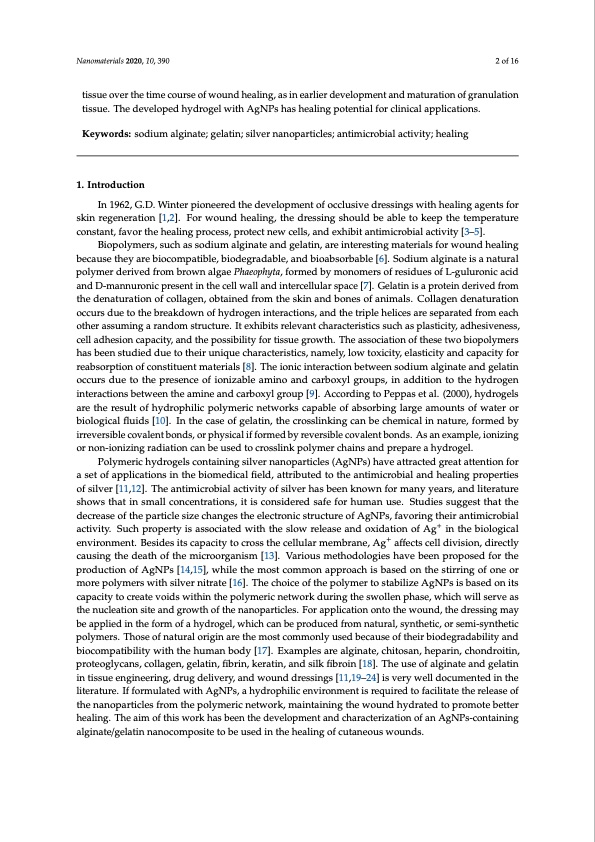
PDF Publication Title:
Text from PDF Page: 002
Nanomaterials 2020, 10, 390 2 of 16 tissue over the time course of wound healing, as in earlier development and maturation of granulation tissue. The developed hydrogel with AgNPs has healing potential for clinical applications. Keywords: sodium alginate; gelatin; silver nanoparticles; antimicrobial activity; healing 1. Introduction In 1962, G.D. Winter pioneered the development of occlusive dressings with healing agents for skin regeneration [1,2]. For wound healing, the dressing should be able to keep the temperature constant, favor the healing process, protect new cells, and exhibit antimicrobial activity [3–5]. Biopolymers, such as sodium alginate and gelatin, are interesting materials for wound healing because they are biocompatible, biodegradable, and bioabsorbable [6]. Sodium alginate is a natural polymer derived from brown algae Phaeophyta, formed by monomers of residues of L-guluronic acid and D-mannuronic present in the cell wall and intercellular space [7]. Gelatin is a protein derived from the denaturation of collagen, obtained from the skin and bones of animals. Collagen denaturation occurs due to the breakdown of hydrogen interactions, and the triple helices are separated from each other assuming a random structure. It exhibits relevant characteristics such as plasticity, adhesiveness, cell adhesion capacity, and the possibility for tissue growth. The association of these two biopolymers has been studied due to their unique characteristics, namely, low toxicity, elasticity and capacity for reabsorption of constituent materials [8]. The ionic interaction between sodium alginate and gelatin occurs due to the presence of ionizable amino and carboxyl groups, in addition to the hydrogen interactions between the amine and carboxyl group [9]. According to Peppas et al. (2000), hydrogels are the result of hydrophilic polymeric networks capable of absorbing large amounts of water or biological fluids [10]. In the case of gelatin, the crosslinking can be chemical in nature, formed by irreversible covalent bonds, or physical if formed by reversible covalent bonds. As an example, ionizing or non-ionizing radiation can be used to crosslink polymer chains and prepare a hydrogel. Polymeric hydrogels containing silver nanoparticles (AgNPs) have attracted great attention for a set of applications in the biomedical field, attributed to the antimicrobial and healing properties of silver [11,12]. The antimicrobial activity of silver has been known for many years, and literature shows that in small concentrations, it is considered safe for human use. Studies suggest that the decrease of the particle size changes the electronic structure of AgNPs, favoring their antimicrobial activity. Such property is associated with the slow release and oxidation of Ag+ in the biological environment. Besides its capacity to cross the cellular membrane, Ag+ affects cell division, directly causing the death of the microorganism [13]. Various methodologies have been proposed for the production of AgNPs [14,15], while the most common approach is based on the stirring of one or more polymers with silver nitrate [16]. The choice of the polymer to stabilize AgNPs is based on its capacity to create voids within the polymeric network during the swollen phase, which will serve as the nucleation site and growth of the nanoparticles. For application onto the wound, the dressing may be applied in the form of a hydrogel, which can be produced from natural, synthetic, or semi-synthetic polymers. Those of natural origin are the most commonly used because of their biodegradability and biocompatibility with the human body [17]. Examples are alginate, chitosan, heparin, chondroitin, proteoglycans, collagen, gelatin, fibrin, keratin, and silk fibroin [18]. The use of alginate and gelatin in tissue engineering, drug delivery, and wound dressings [11,19–24] is very well documented in the literature. If formulated with AgNPs, a hydrophilic environment is required to facilitate the release of the nanoparticles from the polymeric network, maintaining the wound hydrated to promote better healing. The aim of this work has been the development and characterization of an AgNPs-containing alginate/gelatin nanocomposite to be used in the healing of cutaneous wounds.PDF Image | Wound Healing Silver Nanoparticles-Composing Hydrogel

PDF Search Title:
Wound Healing Silver Nanoparticles-Composing HydrogelOriginal File Name Searched:
nanomaterials-10-00390-v2.pdfDIY PDF Search: Google It | Yahoo | Bing
Turbine and System Plans CAD CAM: Special for this month, any plans are $10,000 for complete Cad/Cam blueprints. License is for one build. Try before you buy a production license. More Info
Waste Heat Power Technology: Organic Rankine Cycle uses waste heat to make electricity, shaft horsepower and cooling. More Info
All Turbine and System Products: Infinity Turbine ORD systems, turbine generator sets, build plans and more to use your waste heat from 30C to 100C. More Info
CO2 Phase Change Demonstrator: CO2 goes supercritical at 30 C. This is a experimental platform which you can use to demonstrate phase change with low heat. Includes integration area for small CO2 turbine, static generator, and more. This can also be used for a GTL Gas to Liquids experimental platform. More Info
Introducing the Infinity Turbine Products Infinity Turbine develops and builds systems for making power from waste heat. It also is working on innovative strategies for storing, making, and deploying energy. More Info
Need Strategy? Use our Consulting and analyst services Infinity Turbine LLC is pleased to announce its consulting and analyst services. We have worked in the renewable energy industry as a researcher, developing sales and markets, along with may inventions and innovations. More Info
Made in USA with Global Energy Millennial Web Engine These pages were made with the Global Energy Web PDF Engine using Filemaker (Claris) software.
Infinity Turbine Developing Spinning Disc Reactor SDR or Spinning Disc Reactors reduce processing time for liquid production of Silver Nanoparticles.
| CONTACT TEL: 608-238-6001 Email: greg@infinityturbine.com | RSS | AMP |